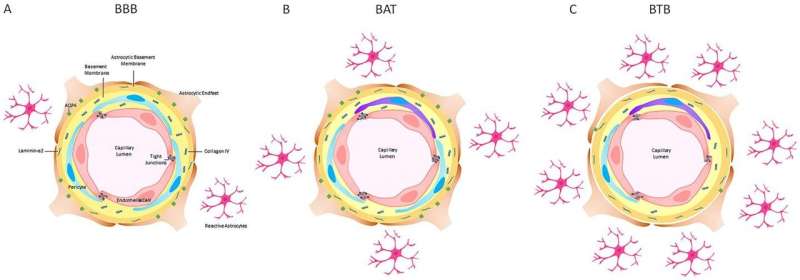Dynamic transition of the blood-brain barrier in the development of non-small cell lung cancer brain

Effective drug delivery through the BTB is one of the greatest therapeutic obstacles in treating brain metastases.
Using an experimental model, the researchers defined key changes within the BTB and the BBB in the brain around the tumor region over time.
These data provide a comprehensive analysis of the BTB in NSCLC brain metastasis.
Dr. L. Tiffany Lyle said "In the United States, lung cancer is the leading cause of cancer-related deaths with a 19% five-year survival rate. In 2019, 142,670 lung cancer patients are expected to die of lung cancer in the United States"
Non-small cell lung cancer is the most common form of lung cancer worldwide and often metastasizes to bone, liver, and brain.
Ten percent of patients are diagnosed with brain metastases at the time of primary diagnosis, and 30 50% of patients are diagnosed with brain metastases over the course of the disease.
NSCLC brain metastases patients receive multimodal therapies including whole brain radiotherapy, stereotactic radiosurgery, surgical resection, immunotherapy and chemotherapy.
In some cases, NSCLC brain metastases shrink with chemotherapy; unfortunately, these metastases typically recur and are resistant to additional treatment.
The authors data details the first comprehensive analysis of the transition of the BBB to the BTB in NSCLC brain metastases over time.
The L. Tiffany Lyle Research Team concluded that this comprehensive analysis correlated BTB and BAT pathology in an experimental model of brain metastatic NSCLC and human NSCLC brain metastases specimens. Overall, the most striking changes were in the loss of aquaporin-4, loss of zona occludens-1, and loss of collagen-IV within the BTB, and these changes were corroborated in human brain metastases.
More information: Gozde Uzunalli et al. Dynamic transition of the blood-brain barrier in the development of non-small cell lung cancer brain metastases, Oncotarget (2019). DOI: 10.18632/oncotarget.27274


















